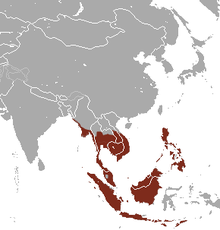நண்டு உண்ணும் குரங்கு
| நண்டு உண்ணும் குரங்கு[1] | |
|---|---|

| |
| உயிரியல் வகைப்பாடு | |
| திணை: | |
| தொகுதி: | |
| வகுப்பு: | |
| வரிசை: | |
| குடும்பம்: | Cercopithecidae
|
| பேரினம்: | Macaque
|
| இனம்: | M. fascicularis
|
| இருசொற் பெயரீடு | |
| Macaca fascicularis Raffles, 1821 | |

| |
| நண்டு உண்ணும் குரங்குகளின் பரவல் | |
| வேறு பெயர்கள் | |
|
Macaca irus F. Cuvier, 1818 Simia aygula L., 1758[3][4][5][6] | |
நண்டு உண்ணும் குரங்கு அல்லது நீண்ட வால் குரங்கு (ஆங்கிலம்: crab-eating macaque அல்லது long-tailed macaque) தென்கிழக்கு ஆசியாவில் காணப்படும் ஒரு வகை குரங்கு ஆகும். இதற்கு நீண்ட நெடிய வரலாறும் உண்டு;[7][8]இது விவசாயப் பூச்சிகளோடும்,[9]சில கோவில்களில் புனித சின்னமாகவும்,[10] மேலும் சமீபத்தில் மருத்துவ ஆராய்ச்சிகளில் ஆய்வுப்பொருளாகவும் காணப்படுகிறது.[11] நண்டு உண்ணும் குரங்குகளின் பிரிவு பெண் குரங்கின் ஆதிக்கத்துடன் தாய்வழி மரபை பின்பற்றும் வம்சமாக உள்ளது,[12] மற்றும் ஆண் குரங்கு பருவ வயதினை அடைந்துவிட்டால் குழுவை விட்டுச் சென்றுவிடும்.[13] மனித இனப்பெருக்கமும், மனிதர்களின் வாழிடமும் குரங்குகளின் வாழியல் இடத்தினை ஆக்கிரமிப்பதால் குரங்குகளின் வாழ்வியல் சூழல் குறைகிறது.[11]
நண்டு உண்ணும் குரங்கு, பெயருக்கேற்றவாறு நண்டுகளை மட்டும் உண்பதில்லை, இவைகள் அனனத்துண்ணி வகையாகும்[14] பல்வேறு விலங்கினங்களையும், தாவரங்களையும் உணவாக உட்கொள்ளும். அதன் உணவுத் தேவையை பொதுவாக பழங்களும், விதைகளுமே 60 – 90% பூர்த்திசெய்கிறது. தங்கள் உணவுத்தேவைகளை கருவிகளைப் பயன்படுத்தி தாமே பூர்த்திசெய்வதாக மியான்மரிலும் தாய்லாந்திலும் ஆவணப்படுத்தப்பட்டுள்ளது.[7]
சான்றுகள்
தொகு- ↑ Groves, Colin (16 நவம்பர் 2005). Wilson, D. E., and Reeder, D. M. (eds) (ed.). Mammal Species of the World (3rd edition ed.). Johns Hopkins University Press. pp. 161–162. பன்னாட்டுத் தரப்புத்தக எண் 0-801-88221-4.
{{cite book}}:|edition=has extra text (help);|editor=has generic name (help); Check date values in:|date=(help)CS1 maint: multiple names: editors list (link) - ↑ "Macaca fuscicularis". பன்னாட்டு இயற்கைப் பாதுகாப்புச் சங்கத்தின் செம்பட்டியல் பதிப்பு 2008. பன்னாட்டு இயற்கைப் பாதுகாப்புச் சங்கம். 2008.
- ↑ P H Napier, C P Groves (July 1983). "Simia fascicularis Raffles, 1821 (Mammalia, Primates): request for the suppression under the plenary powers of Simia aygula L., 1758, a senior synonym. Z.N.(S.) 2399". Bulletin of Zoological Nomenclature 40 (2): 117–118. பன்னாட்டுத் தர தொடர் எண்:0007-5167. http://biostor.org/reference/76280. பார்த்த நாள்: 19 November 2012. "Simia aygula is quite clearly the Crab-eating or Long-tailed Macaque, as Buffon opined as early as 1766.".
- ↑ J. D. D. Smith (2001). "Supplement 1986–2000" (PDF). Official List and Indexes of Names and Works in Zoology. International Trust for Zoological Nomenclature. p. 8. Archived from the original (PDF) on 28 செப்டம்பர் 2012. பார்க்கப்பட்ட நாள் 19 November 2012.
Suppressed under the plenary power for the purposes of the Principle of Priority, but not for those of the Principle of Homonymy
{{cite web}}: Check date values in:|archive-date=(help) - ↑ Wilson, D. E., and Reeder, D. M., ed. (2005). Mammal Species of the World (3rd ed.). Johns Hopkins University Press. பன்னாட்டுத் தரப்புத்தக எண் 0-801-88221-4.
{{cite book}}: CS1 maint: multiple names: editors list (link) - ↑ லின்னேயசு, Carl (1758). Systema naturæ. Regnum animale (10 ed.). p. 27. பார்க்கப்பட்ட நாள் 19 November 2012.
- ↑ 7.0 7.1 Gumert, M.D.; Kluck, M.; Malaivijitnond, S. (2009). "The physical characteristics and usage patterns of stone axe and pounding hammers used by long-tailed macaques in the Andaman Sea region of Thailand". American Journal of Primatology 71 (7): 594–608. doi:10.1002/ajp.20694. பப்மெட்:19405083.
- ↑ Luncz, L. V.; Svensson, M. S.; Haslam, M.; Malaivijitnond, S.; Proffitt, T.; Gumert, M. (2017). "Technological response of wild Macaques (Macaca fascicularis) to anthropogenic change". International Journal of Primatology 38 (5): 872–880. doi:10.1007/s10764-017-9985-6. பப்மெட்:29056799.
- ↑ Long, J. (2003). Introduced Mammals of the World: Their History, Distribution, and Influence. Australia: CSIRO Publishing. p. 74. பன்னாட்டுத் தரப்புத்தக எண் 978-0643067141.
- ↑ "Island of the Monkey God". Off the Fence. Archived from the original on 2013-09-28. பார்க்கப்பட்ட நாள் 2013-09-25.
- ↑ 11.0 11.1 Gumert, MD; Fuentes A; Jones-Engel, L. (2011). Monkeys on the Edge: Ecology and Management of Long-tailed Macaques and their Interface with Humans. Cambridge University Press.
- ↑ van Noordwijk, M.; van Schaik, C. (1999). "The Effects of Dominance Rank and Group Size on Female Lifetime Reproductive Success in Wild Long-tailed Macaques, Macaca fascicularis". Primates 40 (1): 105–130. doi:10.1007/bf02557705. பப்மெட்:23179535.
- ↑ de Ruiter, Jan; Geffen, E. (1998). "Relatedness of matrilines, dispersing males and social groups in long-tailed macaques (Macaca fascicularis)". Proceedings of the Royal Society B 265 (1391): 79–87. doi:10.1098/rspb.1998.0267. பப்மெட்:9474793.
- ↑ Bonadio, C. (2000). "Macaca fascicularis". Animal Diversity Web. பார்க்கப்பட்ட நாள் 26 September 2013.
